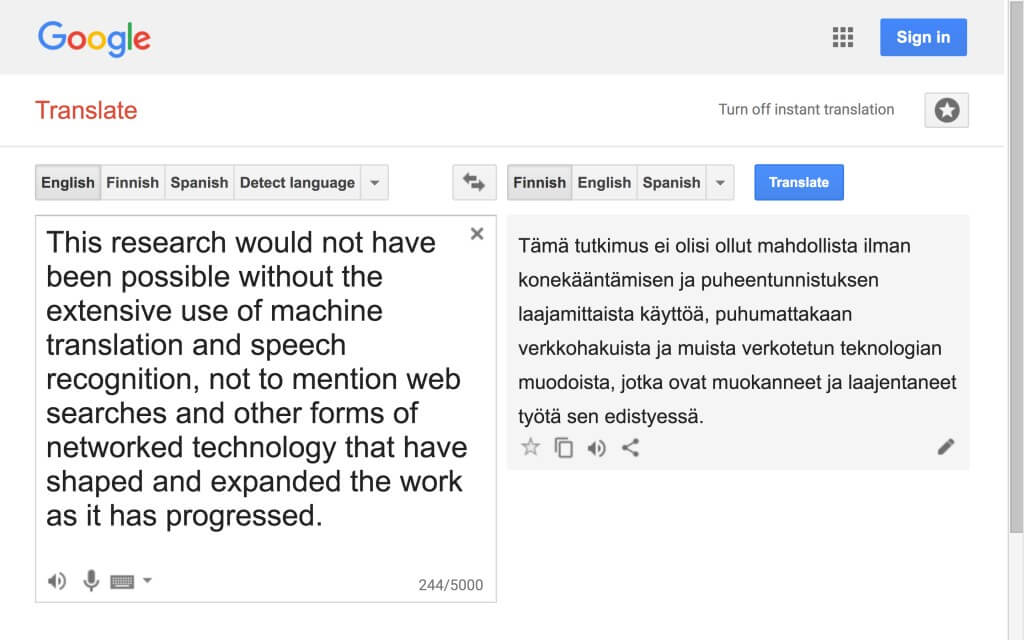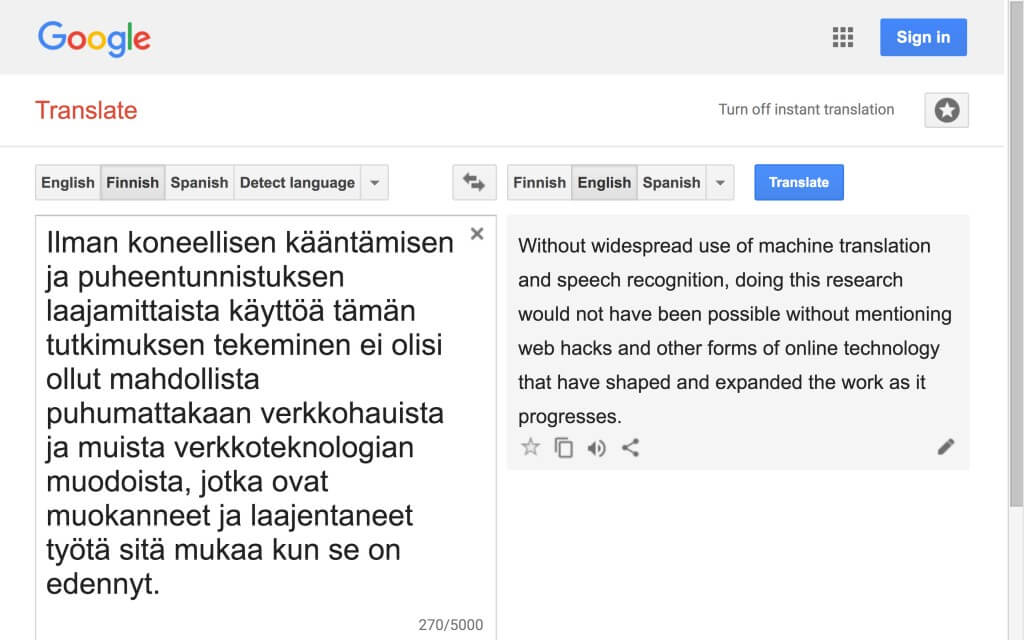1.10 Fragment 10
- Fragment 10
In fragment 10, DAR clearly reveals something essential to the internal logic of this research. They argue that various forms of networked technology have “shaped and expanded” the work. The wording can be considered a key to this study. DAR emphasizes the effect digital media has on the research and the resulting indebtedness of the research to these technologies. The fact that this is only the second “stand-alone” fragment—i.e. only the second not to adapt any one particular Hayles passage (see 1.4)—further increases its significance.
Fragment 10 suggests that digital technology not only supports the research but is a key factor in determining its methods and outcomes. Instead of speculating on whether fragment 10 conceals a discomfort and a concern on DAR’s behalf—discomfort arising from their dependency on technology or how it has influenced the research—I wish here to stay with the phrase “shaped and expanded” by examining it on a more general level. More specifically, I wish to regard it from the perspective of philosopher of law Antoinette Rouvroy’s concept of algorithmic governmentality.
Algorithmic Governmentality
In her article “The end(s) of critique—Data behaviourism versus due process,” Rouvroy asks whether critical thinking is still possible after the computational turn (1.10EN1), given the state that knowledge production, the exercise of power, and even human subjectivity are in as a result of it. The “epistemic universe” (de Vries & Hildebrandt 2013, 5) after the computational turn maintains a false objectivity and effectively rejects the goals of modern rationality, which involve empirical experiments and deductive, causal logic. Rouvroy argues that this new epistemic universe or “truth regime” is chracterized by a form of governance that differs in two significant ways from prior systems: 1) it no longer assumes that its subjects are rational, moral, and intentional, and 2) it is no longer based on socially tested classifications. (Rouvroy 2013bEN, 144, 146)
Algorithmic governmentality—the name Rouvroy gives this new form of governance—promises to take better account of individuality and personal merit, needs, abilities, and preferences through ubiquitous profiling. In reality, it fails to take into account the reflective abilities of individuals and their inclusion in collective structures, as it focuses solely on algorithmically created profiles. Exercising critique has become increasingly difficult after the computational turn, as concepts such as “experiment,” “trial,” “evaluation,” and even “experience” have disappeared or lost their meaning. (Rouvroy 2013bEN, 144)
The crux of Rouvroy’s critique is that these same concepts are necessary in all areas of a functioning society, such as academia, the judiciary, and the very existence of the individual. In her article, she defends that which, in comparison to algorithmic governmentality, appears as human weakness. Instead of the speed of automated regulation, she emphasizes the importance of human inefficiency. The influence of the human subject will only be maintained if human meaning-making is given the time and space to restore (at least in part) its autonomy. (Rouvroy 2013bEN, 145)
As an example of such productive human inefficiency, Rouvroy points to delays in legal proceedings (Rouvroy 2013bEN, 145). In the context of the current research, delay or hesitation of another kind (but perhaps with similar effect) is evident in the video documentation in 1.8, in which the human writer-performers take time to adapt to and reposition themselves in relation to their algorithmic co-writers. A sense of meaningfulness is lost in the process, if the human actors are not given enough time to attempt creating coherence. When this occurs, algorithms can be considered to dominate writing processes in the same way as they, in Rouvroy’s view, dominate society as a whole.
Algorithmically Enabled or Controlled Research
In relation to fragment 10, Rouvroy’s critical remarks give reason to ask whether the current research project is algorithmically enabled or controlled (here I refer to the study as a whole, including the artistic parts, DAR’s adaptation, and my commentary). In other words, is the role of algorithmic processes here supportive, complementary, and even creative—as DAR, adapting Hayles’s argumentation, maintains—or governing, restrictive, and inhibitory, as might be claimed on the grounds of Rouvroy’s hypotheses. Clearly, there is a tension between these two positions. Hayles seeks to find constructive interventions in the “contemporary techno-linguistic condition” (Raley 2018), whereas Rouvroy seems to advocate radical (albeit unnamed) change to it—if not the complete abolishment of current systems.
For Hayles, the computational turn—or what she refers to as “media upheavals” (Hayles 2012, 1)—has led to a diversification of the means and modes of critical thought, despite substantial problems related to digital technology. In contrast, in Rouvroy the digital world has closed in on itself to produce digital objects that we humans cannot understand, let alone use (Rouvroy 2013EN). With regard to fragment 10 and DAR’s mention of web searches, Rouvroy’s critique of the current state of knowledge production is particularly pertinent: the relations of webpages to each other, rather than their content, determine their status in the information hierarchies of the Internet (Rouvroy 2013EN).
In this connection, Rouvroy draws attention to how programs such as Google’s PageRank algorithm have replaced the “harsh debates” (Rouvroy 2013EN) that have been an integral part of more traditional methods of weighing the reliability of information. Due to the way PageRank and other similar algorithms work, the status of websites improves as other pages link to them. Links are like votes: the one with the most votes is more likely to appear at the top of the search results. (Kaplan 2014, 57)
“Algorithmically produced fake content” constantly corrupts searches by artificially bolstering the position of certain pages, as Frederik Kaplan summarizes (Kaplan 2014, 58). Against this backdrop, Rouvroy’s argument that only hyperlinks and their quantity matter anymore—an issue I frequently contemplate when writing this thesis—is hardly surprising. This view, of course, stands in stark contrast with Google co-founders Lawrence Page’s and Sergey Brin’s description of PageRank as “a method for rating Web pages objectively and mechanically, effectively measuring the human interest and attention devoted to them” (Page et al. 1999EN, 1).
Non-Robust Translations in Service of Robust Knowledge
How can we assess whether academic and artistic projects such as this research benefit from the inclusion of algorithmic processes? In other words, what could algorithmic governmentality (or its hitherto unnamed constructive counterscenario) result in, in the context of artistic research? Frankly, are DAR and I deceiving ourselves by believing in the autonomy and incorruptibility of our work, when some of the methods we use resist or at least challenge traditional assessment methods?
Hayles and Rouvroy present strikingly different viewpoints, which is why it is tempting to further exploit this contrast. Instead, however, I would like to close this response to fragment 10 by providing one example of how the observations made during this research support Hayles’s more technology-oriented view. For this purpose, I quote from Rouvroy the following point: “The ‘force’ of algorithmic governmentality is thus proportional to its ‘non-robustness’ (if one takes robustness to be the capacity to sustain challenges and critiques). This ‘non-robustness’ is also what makes the aesthetics of algorithmic governmentality: an aesthetic of fluidity, continuity, real time adaptation, immediacy, dynamism, plasticity, non-obtrusiveness, seamlessness etc.” (Rouvroy 2013bEN, 152).
Rouvroy’s critique is both meaningful and one-sided. It is significant because the changes brought about by the computational turn concern all areas of public and private life, as Rouvroy compellingly argues. What renders it one-sided is that it completely ignores the possibility that digital media could be used for purposes of revealing and resisting the very problems they give rise to, a view central to Hayles’s project (Hayles 2012, 18).
For example, with algorithmic translations, it is clear that they are not robust in Rouvroy’s terms as defined above. Normally, machine translations are only evaluated when developments in the field of machine translation are to be measured (1.10EN2). In commonplace use, they are merely quick translations that the user of the program will not spend much time evaluating, regardless of their usefulness or precision. However, my main argument against the theory of algorithmic governmentality is that algorithmic translations—as well as other forms of algorithmic processing, including web searches—can function as parts of processes that produce not only robust translations but also robust knowledge.
Notes
1.10EN1
Rouvroy favors the term computational turn, whereas Haverinen & Suominen (Haverinen & Suominen 2015EN) opt for digital turn, because the changes the terms suggest “touch upon all areas of life and thus also extend to areas of research.”
1.10EN2
BLEU (bilingual evaluation understudy) is an algorithm that is commonly used to evaluate the quality of text machine translated from one natural language into another. (Wikipedia 31 July 2017)

